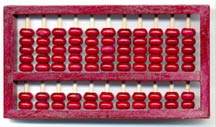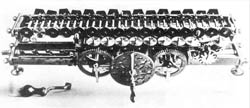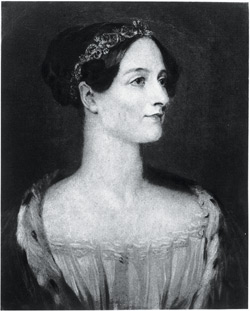1.
The earliest calculating device—other than one's fingers and toes—was likely an abacus, first used in Babylon,
originally no more than markings in the dust. By the Middle Ages, it took its familiar form in Europe and Asia, where the position of beads on a wire represent numbers and can be used to perform simple tasks such as addition and subtraction, as well as more abstract functions such as multiplication, division, and square roots. Soon, however, the introduction of Arabic numerals to Europe and the development of higher mathematical concepts such as logarithms could not be easily represented by beads on a wire, and so pen and paper replaced the abacus.
2.
In the sixteenth century, John Napier (Scottish mathematician, 1550-1617) developed logarithms, a mathematical concept that allowed the process of multiplication to be broken down into a series of discrete steps using addition. He produced a device, known as Napier's Bones, which simplified multiplication and was the forerunner of the slide rule.
3.
Wilhelm Schickard (German scientist and mathematician, 1592-1635) built the first mechanical calculating device in 1623, which incorporated a set of Napier's Bones. The device could add, subtract, multiply, and divide.
4.
Blaise Pascal (French mathematician and philospher, 1623-1662) developed the Pascaline, a mechanical adding machine, in 1642. His father was a tax commissioner, and his device was a way to mechanize the labor of calculating tax tables in an age in which the dominant technology was that of clocks and gears. Numbers were represented by the positions of gears in the mechanism, and calculation consisted of physically changing the angle of the gears.
5.
The Stepped Reckoner, invented by Gottfried Wilhelm Leibniz (German philosopher and mathematician, 1646-1716), could calculate square roots as well as basic arithmetic functions. It used gears and a movable carriage, which were also featured in later adding machines and the nineteenth-century mechanical typewriter.
6.
In the mid-nineteenth century, Charles Babbage (English mathematician and philosopher, 1791-1871) and Lady Ada Lovelace (English program creator, 1815-52) began their collaboration on the Analytical Engine, the successor to Babbage's Difference Engine, a mechanical calculating machine. The Difference Engine could perform certain arithmetic functions to twenty decimals, and its construction required a great many engineering advances, many of which
Babbage developed himself. He began work on the Difference Engine as a means to calculate tide tables for the British Navy, but he abandoned the project halfway through for the more ambitious Analytic Engine, which he never completed. While most
machines of the time were single purpose—designed and built to perform a single mathematical task such as addition—the
Analytical Engine was conceived to perform any arithmetic function and, more importantly, it could make decisions on the basis of its calculations. In effect, it could think for itself. While Babbage is given credit for the Analytical Engine's design, Lovelace is credited as the first programmer. An early programming language, Ada, was named after her.
7.
ENIAC (Electronic Numerator, Integrator and Computer), completed in the mid-1940s, was the first general-purpose electronic computer, created by a team that was headed by John W. Mauchly (American physicist, 1907-1980) and J. Presper Eckert (American electrical engineer, 1919-95), Jr. at the University of Pennsylvania. Unlike earlier computers or calculating machines, it could be reprogrammed for a variety of tasks. But its programs were stored in the physical configurations of wires: it was difficult to reprogram—a process that could take days—and it could not change the program or make decisions after it had been wired. It was, in essence, a very fast and complicated adding machine, but lacked the ability to branch, and so lacked an essential feature of modern computers. During its construction, physicist John von
Neumann (Hungarian-born mathematician, 1903-57) joined the team, and together they proposed creation of the EDVAC, effectively making
ENIAC obsolete before it was even completed.
8.
EDVAC (Electronic Discrete Variable Automatic Computer) was an early stored-program computer completed in 1952. Unlike
ENIAC, its program was stored in the same electronic space as its data, both of which were in
binary format. This allowed its
programs to be loaded much more quickly than
ENIAC's; furthermore, the EDVAC programs could change themselves. Its
architecture is the basis for all modern computing.
9.
In 1948, Claude Shannon (American electricial engineer and mathematician, 1916-2001) published his paper "A Mathematical Theory of Computation," which gave birth to modern information theory. His paper showed that all information media—text, voice, pictures—could be represented in
binary form. That is, media could be encoded into
digital files. He also coined the term
"bit"—a contraction of
"binary" and "digit."





